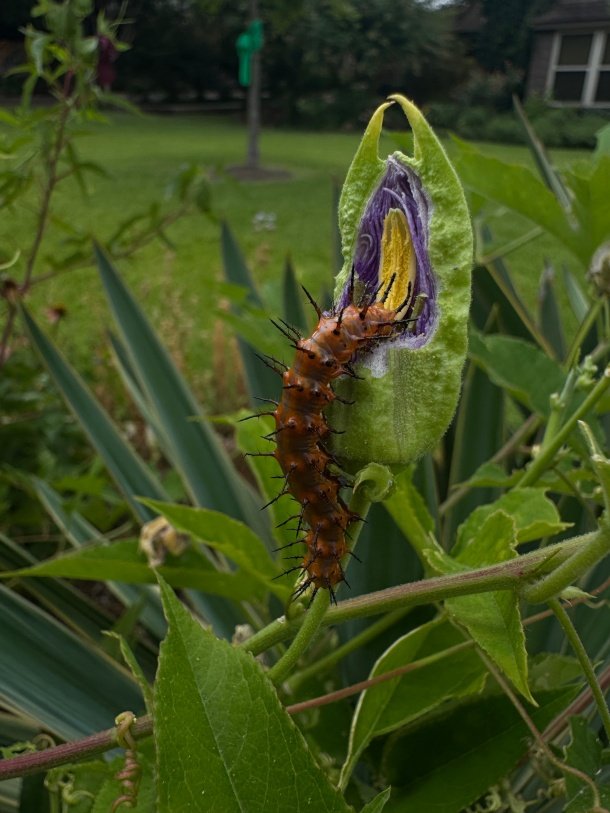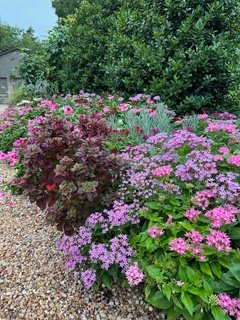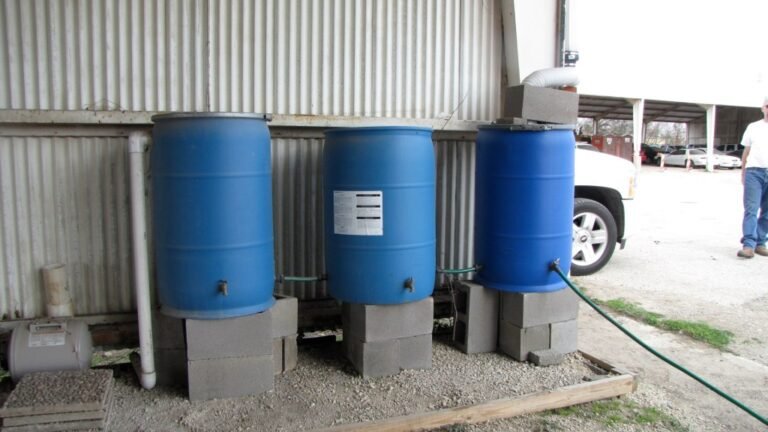
August 25, 2025
Passion vine has been tumbling over my mailbox for years. This summer I experienced the life cycle of the gulf fritillary from egg to caterpillar to chrysalis to butterfly.
This fascinating journey captivated me for weeks. On July 25th, caterpillars were covering the leaves and blooms of the passion vine. They looked menacing with their reddish-brown spiked bodies.
But there was one who was unlike the others – It had spikes, but had a white milky covering, and it was hanging in a definite “J” shape from my recently-bloomed color guard yucca stalk.
Excited, I ran to get my phone for a time lapse video, but the location and time that it would take to capture, encouraged a different approach. Pictures were snapped before running errands. Alas, upon returning the caterpillar had created the chrysalis and was unassumingly hanging on part of the stalk right at eye level. Had the caterpillar not been seen, it would have been difficult to recognize the chrysalis, as it looked like the material of the spent stalk. It was unnoticeable, unless it was seen in progress. Upon closer examination, the caterpillar shape was recognizable, and the lower portion was where wings formed.
Every morning began with observations – here are some of them:
1. Check on the chrysalis – no real change for about a week – information suggested that it would remain 5-8 days before emerging. Search for more.
2. Look for caterpillars– spiky, reddish brown color, they came in all sizes from very small to about 1 -2 inches long. They were in every part of the passion vine — plain sight, under the leaves, on the stems, and even in the flowers, but were voracious eaters.
3. Observe the native passion vine being ravaged by the very hungry caterpillars. -As a host plant, its lush vegetation, quicky changed to a sickly mass of stems, stripped leaves and decimated flowers. Nothing to do but watch, the plant would soon regrow.
4. Watch gulf fritillary butterflies deposit eggs on the leaves, quickly flitting away to find another spot to do it again.
5. Cringe as Wasps swoop in and sting vulnerable caterpillars. It was disheartening to view but realized that this is part of the natural process.
The observations of the chrysalis were routine until Saturday morning, August 2nd; – there was a gulf fritillary butterfly with his legs clinging to the chrysalis from which he had just emerged. Not moving much, just drying his wings and hanging out. After a few minutes it began to slowly fly to another stalk, then paused–It’s hard work coming out! After several minutes, there was more movement, brief flights, and then it disappeared into the flurry of other butterflies. The short-lived journey of this Gulf fritillary began (14-24 days).
During my daily walk around, it was noted that two eggs were deposited on the painted wood of my mailbox. The contrasting pale yellow color made it easy to observe. With a magnifying glass and ruler in hand., I peered closer at the eggs. For over a week the tiny egg remained unchanged, but then the color turned to a reddish-brown, becoming the smallest of caterpillars (3 mm) in search of passion vine to devour. They didn’t have far to travel as the native passion vine encircled the mailbox.


Checking on the cats became a morning pattern, and I was not disappointed when stumbling on another gulf fritillary emerging. This one was located on a coneflower stem. The wings were still droopy indicating that it had very recently exited the chrysalis and needed to dry. As I watched, another gulf fritillary came, flitted his wings slowly and covered him as he hung to the chrysalis. This behavior mesmerized me. Was it protecting him while his wings were drying out? After a short while, maybe 10-15 minutes, they were in flight and yet another chrysalis was abandoned.
There’s so much I don’t know about this process but seeing it up close and personal reminded me that the wonder of God’s creation is incredibly complex and so beautiful. With our busy schedules this is a good reminder to take time to enjoy nature that is all around and let that inspire and encourage us.
Starla Willis, Dallas County Master Gardener Class of 2011

Read more about Passion Flower, the host plant, on this blog.







